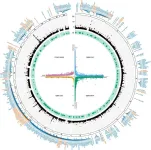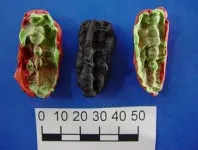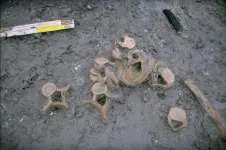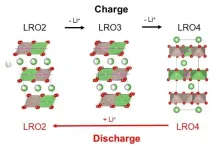(Press-News.org) Glaucoma is the leading cause of irreversible blindness around the globe, affecting up to 44 million people. Although people of African ancestry are most frequently and severely affected by this hereditary disease, its genetic underpinnings in this population have rarely been studied. Now, a team of investigators has published findings revealing previously unknown inherited genetic variants that contribute to primary open-angle glaucoma (POAG), the most common form of the disease. The study was based on the analysis of 11,275 individuals of African descent and is being published January 18, 2024, in Cell.
“Individuals with African ancestry are five times more likely to be affected by glaucoma and up to 15 times more likely to experience vision loss or blindness from the disease compared to individuals with European ancestry,” says corresponding author Joan O’Brien, MD, Director of the Penn Medicine Center for Genetics of Complex Disease, who was funded by a $17.9 million grant from the National Institutes of Health for this research. “Our current treatments for this blinding disease are inadequate, and precision medicine could be applied if we more clearly understood the full pathophysiology of this inherited neurodegeneration.”
O’Brien explains that this research was made possible thanks to key contributions from glaucoma specialists of African ancestry and other Black community leaders living in the Philadelphia area, who were able to boost enrollment in the research because of increased trust within the community. Scientists from fields including genetics, ophthalmology, and computational biology also made important contributions to the paper.
POAG can occur when normal drainage of eye fluid becomes blocked, leading to a buildup of pressure within the eye. If the intraocular pressure rises too much, it can damage the optic nerve and result in permanent vision loss. People with POAG generally experience a loss of peripheral vision first, followed by loss in the central field of vision. Unfortunately, the disease has no early symptoms, and by the time vision loss is experienced, permanent damage usually has already occurred.
“Elevated intraocular pressure is currently the only targetable component of the disease, but many patients maintain normal pressure levels or do not respond to pressure-lowering therapies,” says co-author Rebecca Salowe, MSE, Research Project Manager at UPenn. “This suggested to us that POAG has additional underlying mechanisms that could be elucidated by genetic studies.”
In this study, the investigators worked with Black community leaders to organize glaucoma screenings in churches and senior centers. They also worked with a Black-owned radio station (WURD Radio) on a campaign promoting the importance of glaucoma screening in the Black community. The screenings were free, and participants received free lunch whether or not they agreed to enroll in the study.
The investigators ultimately were able to collect data and genetic samples for 11,275 people (6,003 individuals with glaucoma and 5,272 controls). Importantly, the enrollees were also given the opportunity to either enroll in or opt out of future studies.
Using genome-wide association studies and other forms of genetic analysis, the team identified two novel gene variants implicated in the formation of glaucoma. These variants were rs1666698, which is tied to the gene DBF4P2, and rs34957764, which is linked to the gene ROCK1P1.
A third variant, rs11824032, which is tied to ARHGEF12, was also identified. This variant was previously associated with cup-to-disc ratio, a measure of glaucoma severity, in a genetic co-localization analysis.
When the team compared their findings to results primarily featuring people of European descent, they found these variants were more common in people of African ancestry.
"This work highlights the essential role of diversity in genetic research,” says Shefali Verma, PhD, an assistant professor in pathology and laboratory medicine at UPenn. “Without our focus on this specific ancestry group, these unique and critical insights might have remained lost, and we would not have been able to substantially enhance our understanding of the genetics behind POAG in this overaffected population."
The researchers were able to validate results in the Penn Medicine BioBank, an in-house repository of genetic information linked to health records. It includes a particularly diverse collection of genetic material.
“To enhance our work, we were able to identify patients in the Penn Medicine BioBank with glaucoma and controls to validate the genetic effects we gleaned from the initial cohort we analyzed,” explains Marylyn Ritchie (@MarylynRitchie), PhD, director of the Institute for Biomedical Informatics at UPenn. “Without that resource, it would have been much more difficult to produce such strong work.”
The team is currently focused on developing better methods for diagnosing glaucoma early, when it’s most amenable to treatment. Using identified variants, the team developed a polygenic risk score that outperformed a similar risk score developed using information from individuals of European ancestry. This improved risk score could help patients make decisions about screening and treatment for glaucoma before it produces vision loss.
“We are now working with community leaders to lead us in determining which other diseases over-affect this understudied population and are of greatest importance for further screening and research,” O’Brien says. “We are also sharing our genetic database with other researchers across departments and schools that are studying diseases that over-affect African ancestry populations. These collaborations are resulting in much more research on the health of a population that has been historically understudied.”
###
This work was funded primarily by the National Eye Institute and the Vision Research Core Grant.
Cell, Verma et al. “A multi-cohort genome-wide association study in African ancestry individuals reveals novel risk loci for primary open-angle glaucoma” https://cell.com/cell/fulltext/S0092-8674(23)01338-7
Cell (@CellCellPress), the flagship journal of Cell Press, is a bimonthly journal that publishes findings of unusual significance in any area of experimental biology, including but not limited to cell biology; molecular biology; neuroscience; immunology; virology and microbiology; cancer; human genetics; systems biology; signaling; and disease mechanisms and therapeutics. Visit http://www.cell.com/cell. To receive Cell Press media alerts, contact press@cell.com.
END
Damage caused by sea level rises could cost the EU and UK economies up to 872 billion Euros in total by the end of the century, according to a modelling study published in Scientific Reports.
Ignasi Cortés Arbués, Theodoros Chatzivasileiadis, Tatiana Filatova and colleagues modelled the potential economic impacts of sea level rises for 271 European regions by 2100 under a high emissions scenario (SSP5-RCP8.5) with no new coastal protection measures implemented after 2015. They combined ...
Members of a hunter-gatherer group that lived in south-western Scandinavia during the Mesolithic era — approximately 10,000 years ago — may have been affected by tooth decay and gum disease, according to a study published in Scientific Reports.
Emrah Kırdök, Anders Götherström and colleagues sequenced the DNA found on three pieces of birch tar — a substance made from heated birch bark — that were excavated in the 1990s from Huseby Klev, Sweden and have been dated to between 9,890 ...
PHILADELPHIA— A new analysis focusing specifically on people of African ancestry identified three gene variants that may be contributing to this population’s susceptibility to developing and being blinded by glaucoma. People of African ancestry are five times as likely as others to develop glaucoma and up to 15 times as likely to be blinded by the condition, but the vast majority of research has used data from people of European ancestry. Led by researchers at the Perelman School of Medicine at the University ...
By 2060, according to the Alzheimer’s Association, nearly one in four Americans will be in an age bracket at elevated risk of cognitive decline and Alzheimer’s disease unless interventions can help preserve cognitive function before deficits begin. The COcoa Supplement and Multivitamin Outcomes Study (COSMOS) is a large-scale, nationwide, randomized trial rigorously testing cocoa extract and multivitamin supplements directed by researchers at Mass General Brigham. Two previously published studies of cognition in COSMOS suggested a positive effect for a daily multivitamin. ...
Nurse home visits to disadvantaged mothers can significantly reduce their rates of hypertension and their daughters’ likelihood of obesity, finds a new reanalysis of health data by a team led by a UCL researcher.
The study, published in the journal JAMA Network Open, reanalysed data taken as part of a Nurse-Family Partnership trial started more than 30 years ago – The Memphis New Mothers Study (1990-1994). The researchers found that prenatal and infancy nurse home visits decreased the likelihood of daughters being obese by 55% and being severely obese by 81% in adolescence. Similarly, mothers of girls showed a decrease ...
About The Study: The findings of this study that included 31 participants ages 65 to 79 suggest that older drivers, even if they regularly use cannabis, show evidence of impaired driving performance after smoking cannabis. Weaving was increased and speed was decreased at 30 minutes after smoking, which was not correlated with blood tetrahydrocannabinol (THC) concentrations; subjective experience and self-reports of impaired driving persisted for three hours.
Authors: Patricia Di Ciano, Ph.D., of the Centre for Addiction ...
About The Study: This nonrandomized controlled trial of 108 patients with advanced Parkinson disease found that at 5-year follow-up quality of life remained stable in the deep brain stimulation of the subthalamic nucleus (STN-DBS) group and worsened in the standard-of-care medication group, mainly driven by the favorable effect of STN-DBS on mobility. These findings may provide helpful information when counseling patients on the efficacy of STN-DBS for Parkinson disease and monitoring patients postoperatively in long-term follow-up.
Authors: Stefanie T. Jost, Ph.D., and Haidar S. Dafsari, M.D., of the University of Cologne, Germany, are the corresponding ...
Philadelphia, PA (January 18, 2024) – Understanding why we overeat unhealthy foods has been a long-standing mystery. While we know food's strong power influences our choices, the precise circuitry in our brains behind this is unclear. The vagus nerve sends internal sensory information from the gut to the brain about the nutritional value of food. But, the molecular basis of the reward in the brain associated with what we eat has been incompletely understood.
Now, a new study published in Cell Metabolism by a team from the ...
What did people eat on the west coast of Scandinavia 10 000 years ago? A new study of the DNA in a chewing gum shows that deer, trout and hazelnuts were on the diet. It also shows that one of the individuals had severe problems with her teeth.
Some 9 700 years ago, a group of people were camping on the west coast of Scandinavia, north of what is today Göteborg. They had been fishing, hunting and collecting resources for food. And some teenagers, both boys and girls, were chewing resin to produce glue, just after ...
1. A research team consisting of the National Institute for Materials Science (NIMS) and Softbank Corp. has found that voltage hysteresis in Li2RuO3—a high-energy-density rechargeable battery cathode material—is caused by differences in the intermediate crystalline phases formed during charge and discharge processes. Voltage hysteresis is a phenomenon detrimental to lithium (Li)-ion batteries in which discharge voltage becomes significantly lower than charge voltage. These results revealed a voltage-hysteresis-causing mechanism inconsistent with conventional theory.
2. ...




